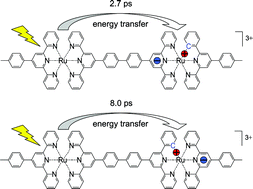Site-specific electronic couplings in dyads with MLCT excited states. Intramolecular energy transfer in isomeric Ru(ii)–Ru(ii) cyclometalated complexes†
Abstract
The rod-like binuclear complexes [(ttpy)Ru(tpy-ph2-phbpy)Ru(ttpy)]4+ and [(ttpy)Ru(tpy-ph2-tpy)Ru(phtbpy)]4+ (for abbreviations, see text) have been synthesized and characterized. In both complexes, the polypyridine Ru(II) centers have (N^N^N)Ru(N^N^N) and (N^N^N)Ru(C^N^N) coordination environment. The two isomeric species differ in whether the cyclometalating carbon resides on the bridging or on the terminal

- This article is part of the themed collection: In honour of Vincenzo Balzani

 Please wait while we load your content...
Please wait while we load your content...